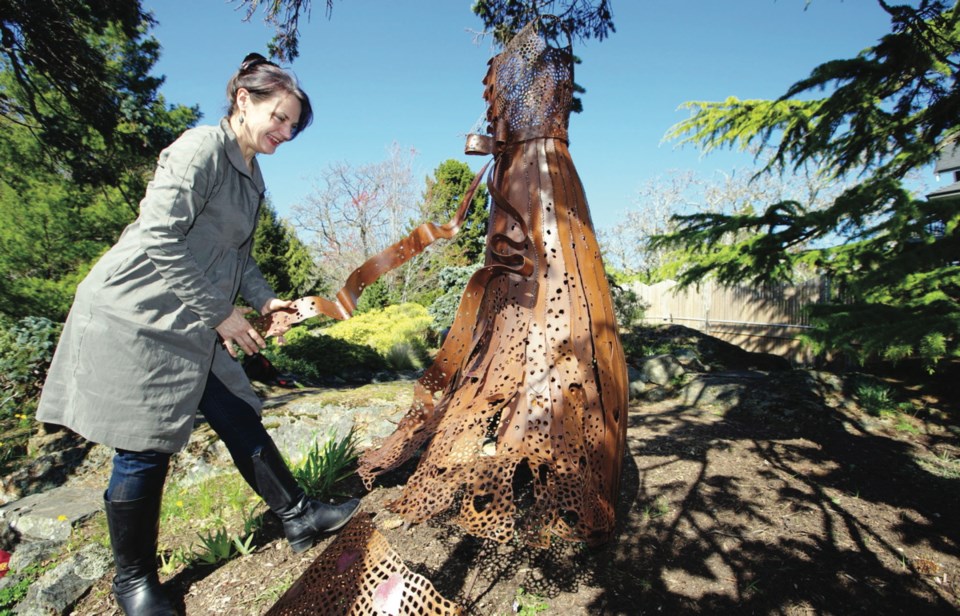To conjure up the indomitable spirit of a Shanghai-born princess, artist Bev Petow fashioned 200 maple leaves out of hard, cold steel.
These metal leaves, in seven sizes, were painstakingly hand-cut, hammered and welded together in the shape of a ballgown. An acid wash — combined with regular rainfall outside Petow’s East Sooke studio — has intentionally left the life-sized artwork with an attractive rust veneer.
It’s one of four dress sculptures Petow created for a new exhibit, Haute Couture, running all summer at Abkhazi Garden. These pieces, which sell for up to $10,000 each, are inspired by ballgowns owned by the late Peggy Abkhazi, who created the garden with her husband, Nicholas Abkhazi, an exiled Georgian prince.
With the maple leaf dress, Petow’s notion was to provide an artistic interpretation of Peggy’s arrival in Canada following globe-trotting and internment in a camp near Shanghai during the Second World War. (It’s said Abkhazi purchased her passage to North America with travellers’ cheques hidden in a talcum-powder can during her confinement.)
“She came here to find a place to land after everything was in chaos globally,” Petow said.
Another dress sculpture is Dragon Aunt, a gleaming steel work resembling a Japanese-style high-collared gown and cape. The shoulders and front — embossed with giant dragonflies — are cut with holes to give the sculpture a lacy look. Yet another sculpture, Bleeding Heart, is inspired by the notion that Abkhazi Garden is “the garden that love built” as well as the bleeding heart flowers growing on Petow’s own property.
The project was suggested and curated by Celia Duthie, who runs Salt Spring Island’s Duthie Gallery. She’s a long-time champion of Petow, a late bloomer who learned to weld in her forties.
Petow was able to see some of Abkhazi’s old gowns, although her sculptures are not intended as literal copies. The dresses were stored in a cardboard box in the basement of the Abkhazi house.
“Some of them are fancy. They’re all handmade, so they’re quite lovely. She had nice taste,” said the artist, interviewed at her East Sooke studio.
Petow said she was equally inspired by Abkhazi’s biography, especially admiring her resilience in the face of adversity.
As well, the artist feels a connection with Abkhazi because she, like Petow, moved to Canada in mid-life. Petow was in her mid-forties when she immigrated here from Portland. A native of Grants Pass, Oregon, she came here because she’d married a Canadian.
Her road to becoming a metal sculptor was circuitous. Petow has had many different jobs. She was a graphic designer (she still does this occasionally), a masseuse in California for 15 years and, for a time, a nutritionist.
Over the years, her creativity manifested itself in different ways. She did drawing, ceramics, macramé, collage and painting. Petow is also a gifted seamstress, able to cut designs without patterns.
Before becoming a sculptor, she’d aimed to be an art therapist, studying at Portland Marylhurst University. As a prerequisite to entering graduate studies, Petow was interviewed by a panel. Afterwards, she opened a door and accidentally walked into a closet.
Petow took this as a sign.
“That’s what it felt like, like I’d be walking back into a closet, something I wasn’t bone-deep happy about,” she said with a smile. “It was a funny moment. I just sort of laughed all the way home.”
Back home in Grants Pass, her father was a mechanic. Petow was comfortable with tools, having grown up around them. At the age of 45, she took welding courses and became interested in metalwork as a art form.
“I came at welding uninhibited, not knowing what I couldn’t do. They called me the ‘welding witch.’ ”
In 2009, her best friend phoned to say she had leukemia. Petow took care of her in her final days. After her friend died, she fell into a depression, just lying on a couch. One day, her friend’s voice came into her head, saying: “Go to the studio.”
To honour her friend, a fellow fashionista, Petow made her a metal dress sculpture, her first one. It was a simple halter-style dress, like what a little girl might wear. She entered it in the Sooke Fine Arts Show. The sculpture won first prize in the three-dimensional-art category.
That was a tremendous boost for Petow, helping to pull her out of her grief. Not only did the sculpture sell for $1,400, it led to a meeting with an Edmonton art-gallery owner. He offered to give Petow a solo show if she would “make a roomful of dresses.”
So she did. Seven of the eight sculptures sold. It was what Petow calls a “Cinderella moment.”
Petow creates all sorts of metal artworks; however, she’s arguably best known for her metal dresses. So far, she’s made about 30.
She jokingly calls her Sooke studio Bitchenheat Metalworks. Dreamed up by her in-laws over a few bottles of wine, the moniker is a cheeky reference to the welder’s torch … and, perhaps, to Petow’s own feisty tenacity.
Tenaciousness, of course, was one of Peggy Abkhazi’s key characteristics. “There’s a lot I like about her,” the artist said.
What: Haute Couture
Where: Abkhazi Garden, 1964 Fairfield Rd.
When: Opens today, continues to Sept. 30
Admission: By donation (free for members of The Land Conservancy)
